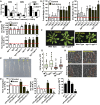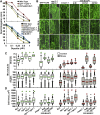Protein Phosphatase 2Cs and Microtubule-Associated Stress Protein 1 Control Microtubule Stability, Plant Growth, and Drought Response
- PMID: 28011693
- PMCID: PMC5304354
- DOI: 10.1105/tpc.16.00847
Protein Phosphatase 2Cs and Microtubule-Associated Stress Protein 1 Control Microtubule Stability, Plant Growth, and Drought Response
Abstract
Plant growth is coordinated with environmental factors, including water availability during times of drought. Microtubules influence cell expansion; however, the mechanisms by which environmental signals impinge upon microtubule organization and whether microtubule-related factors limit growth during drought remains unclear. We found that three Clade E Growth-Regulating (EGR) Type 2C protein phosphatases act as negative growth regulators to restrain growth during drought. Quantitative phosphoproteomics indicated that EGRs target cytoskeleton and plasma membrane-associated proteins. Of these, Microtubule-Associated Stress Protein 1 (MASP1), an uncharacterized protein, increased in abundance during stress treatment and could bind, bundle, and stabilize microtubules in vitro. MASP1 overexpression enhanced growth, in vivo microtubule stability, and recovery of microtubule organization during drought acclimation. These MASP1 functions in vivo were dependent on phosphorylation of a single serine. For all EGR and MASP1 mutants and transgenic lines examined, enhanced microtubule recovery and stability were associated with increased growth during drought stress. The EGR-MASP1 system selectively regulates microtubule recovery and stability to adjust plant growth and cell expansion in response to changing environmental conditions. Modification of EGR-MASP1 signaling may be useful to circumvent negative growth regulation limiting plant productivity. EGRs are likely to regulate additional proteins involved in microtubule stability and stress signaling.
© 2016 American Society of Plant Biologists. All rights reserved.
Figures








Comment in
-
Fine-Tuning Plant Growth in the Face of Drought.Plant Cell. 2017 Jan;29(1):4. doi: 10.1105/tpc.17.00038. Epub 2017 Jan 18. Plant Cell. 2017. PMID: 28100705 Free PMC article. No abstract available.
Similar articles
-
Spatial differences in stoichiometry of EGR phosphatase and Microtubule-associated Stress Protein 1 control root meristem activity during drought stress.Plant Cell. 2022 Feb 3;34(2):742-758. doi: 10.1093/plcell/koab290. Plant Cell. 2022. PMID: 34865106 Free PMC article.
-
Size and activity of the root meristem: A key for drought resistance and a key model of drought-related signaling.Physiol Plant. 2022 Jan;174(1):e13622. doi: 10.1111/ppl.13622. Physiol Plant. 2022. PMID: 34988997
-
Arabidopsis AUGMIN subunit8 is a microtubule plus-end binding protein that promotes microtubule reorientation in hypocotyls.Plant Cell. 2013 Jun;25(6):2187-201. doi: 10.1105/tpc.113.113472. Epub 2013 Jun 4. Plant Cell. 2013. Retraction in: Plant Cell. 2017 Sep;29(9):2306. doi: 10.1105/tpc.17.00468. PMID: 23735294 Free PMC article. Retracted.
-
The microtubule cytoskeleton acts as a sensor for stress response signaling in plants.Mol Biol Rep. 2019 Oct;46(5):5603-5608. doi: 10.1007/s11033-019-04872-x. Epub 2019 May 16. Mol Biol Rep. 2019. PMID: 31098806 Review.
-
Transcriptional Regulation of Protein Phosphatase 2C Genes to Modulate Abscisic Acid Signaling.Int J Mol Sci. 2020 Dec 14;21(24):9517. doi: 10.3390/ijms21249517. Int J Mol Sci. 2020. PMID: 33327661 Free PMC article. Review.
Cited by
-
Molecular evolution and lineage-specific expansion of the PP2C family in Zea mays.Planta. 2019 Nov;250(5):1521-1538. doi: 10.1007/s00425-019-03243-x. Epub 2019 Jul 25. Planta. 2019. PMID: 31346803
-
Phosphorylation regulates the activity of INDETERMINATE-DOMAIN (IDD/BIRD) proteins in response to diverse environmental conditions.Plant Signal Behav. 2019;14(10):e1642037. doi: 10.1080/15592324.2019.1642037. Epub 2019 Jul 17. Plant Signal Behav. 2019. PMID: 31314681 Free PMC article. Review.
-
Protein Phosphorylation Orchestrates Acclimations of Arabidopsis Plants to Environmental pH.Mol Cell Proteomics. 2024 Jan;23(1):100685. doi: 10.1016/j.mcpro.2023.100685. Epub 2023 Nov 23. Mol Cell Proteomics. 2024. PMID: 38000714 Free PMC article.
-
Multi-Locus GWAS for Grain Weight-Related Traits Under Rain-Fed Conditions in Common Wheat (Triticum aestivum L.).Front Plant Sci. 2021 Oct 21;12:758631. doi: 10.3389/fpls.2021.758631. eCollection 2021. Front Plant Sci. 2021. PMID: 34745191 Free PMC article.
-
Genotype-dependent contribution of CBF transcription factors to long-term acclimation to high light and cool temperature.Plant Cell Environ. 2022 Feb;45(2):392-411. doi: 10.1111/pce.14231. Epub 2021 Dec 6. Plant Cell Environ. 2022. PMID: 34799867 Free PMC article.
References
-
- Ban Y., Kobayashi Y., Hara T., Hamada T., Hashimoto T., Takeda S., Hattori T. (2013). α-tubulin is rapidly phosphorylated in response to hyperosmotic stress in rice and Arabidopsis. Plant Cell Physiol. 54: 848–858. - PubMed
-
- Bannigan A., Wiedemeier A.M.D., Williamson R.E., Overall R.L., Baskin T.I. (2006). Cortical microtubule arrays lose uniform alignment between cells and are oryzalin resistant in the Arabidopsis mutant, radially swollen 6. Plant Cell Physiol. 47: 949–958. - PubMed
Publication types
MeSH terms
Substances
LinkOut - more resources
Full Text Sources
Other Literature Sources
Molecular Biology Databases
Research Materials
Miscellaneous

